System Dynamics Tools to Study Mediterranean Rangeland’s Sustainability
Abstract
1. Introduction
2. An Appropriate Research Field for System Dynamics
3. A Suite of Models for Assessing Rangeland Desertification
3.1. A Generic Desertification Model (GDM)
3.2. DESPAS Model
3.3. Extensions of the DESPAS Model
3.3.1. Soil Moisture, Runoff, and Erosion
3.3.2. Shrub–Grass Competition
3.3.3. Supplementary Feeding
3.3.4. Farmers’ Behavior
3.3.5. Price Forming Mechanism
3.3.6. Temporal and Spatial Scales
4. Design and Implementation of Analysis Tools to Explore Rangeland Behavior
4.1. Temporal Trends and “What If” Questions
4.2. Stability Analysis Condition
4.3. Risk Analysis
4.4. Ranking of Factors
4.5. Implementation of ANOVA Test
5. Findings through SD Modeling
5.1. Learnings from Mediterranean Rangelands Modeling
5.2. Multidisciplinarity: Under the Crossfire of Specialists
6. Conclusions
Author Contributions
Funding
Data Availability Statement
Acknowledgments
Conflicts of Interest
References
- Menke, J.; Bradford, G.E. Rangelands. Agric. Ecosyst. Environ. 1992, 42, 217–230. [Google Scholar] [CrossRef]
- Cherlet, M.; Hutchinson, C.; Reynolds, J.; Hill, J.; Sommer, S.; Von Maltitz, G. (Eds.) World Atlas of Desertification; Publication Office of the European Union: Luxembourg, 2018; ISBN 978-92-79-75350-3. [Google Scholar]
- Lund, G. Accounting for the World’s Rangelands. BioOne 2007, 29, 3–10. [Google Scholar] [CrossRef]
- Bedunah, D.J.; Angerer, J.P. Rangeland Degradation, Poverty, and Conflict: How Can Rangeland Scientists Contribute to Effective Responses and Solutions? Rangel. Ecol. Manag. 2012, 65, 606–612. [Google Scholar] [CrossRef]
- Asner, G.P.; Elmore, A.J.; Olander, L.P.; Martin, R.E.; Harris, A.T. Grazing Systems, Ecosystem Responses, and Global Change. Annu. Rev. Environ. Resour. 2004, 29, 261–299. [Google Scholar] [CrossRef]
- Maestre, F.T.; Le Bagousse-Pinguet, Y.; Delgado-Baquerizo, M.; Eldridge, D.J.; Saiz, H.; Berdugo, M.; Gozalo, B.; Ochoa, V.; Guirado, E. Grazing and Ecosystem Service Delivery in Global Drylands. Science 2022, 378, 915–920. [Google Scholar] [CrossRef]
- Maestre, F.T.; Eldridge, D.J.; Soliveres, S.; Sonia, K.; Delgado-baquerizo, M.; Bowker, M.A.; Garc, P.; Gait, J.; Gallardo, A.; Roberto, L. Structure and Functioning of Dryland Ecosystems in a Changing Structure and Functioning of Dryland Ecosystems in a Changing World. Annu. Rev. Ecol. Evol. Syst. 2016, 47, 215–237. [Google Scholar] [CrossRef]
- Reynolds, J.F.; Smith, D.M.S.; Lambin, E.F.; Turner II, B.L.; Mortimore, M.; Batterbury, S.P.J.; Downing, T.E.; Dowlatabadi, H.; Fernandez, R.J.; Herrick, J.E.; et al. Global Desertification: Building a Science for Dryland Development. Science 2007, 316, 847–851. [Google Scholar] [CrossRef]
- Allington, G.R.H.; Li, W.; Brown, D.G. Modeling System Dynamics in Rangelands of the Mongolian Plateau. In Proceedings of the Trans-disciplinary Research Conference: Building Resilience of Mongolian Rangelands, Ulaanbaatar, Mongolia, 9–10 June 2015; pp. 216–221. [Google Scholar]
- Fu, Q.; Feng, S. Responses of Terrestrial Aridity to Global Warming. J. Geophys. Res. Atmos. 2014, 119, 7863–7875. [Google Scholar] [CrossRef]
- Huang, J.; Yu, H.; Guan, X.; Wang, G.; Guo, R. Accelerated Dryland Expansion under Climate Change. Nat. Clim. Chang. 2015, 6, 166–172. [Google Scholar] [CrossRef]
- Lin, L.; Gettelman, A.; Fu, Q.; Xu, Y. Simulated Differences in 21st Century Aridity Due to Different Scenarios of Greenhouse Gases and Aerosols. Clim. Chang. 2018, 146, 407–422. [Google Scholar] [CrossRef]
- Park, C.-E.; Jeong, S.-J.; Joshi, M.; Osborn, T.J.; Ho, C.-H.; Piao, S.; Chen, D.; Liu, J.; Yang, H.; Park, H.; et al. Keeping Global Warming within 1.5 °C Constrains Emergence of Aridification. Nat. Clim. Chang. 2018, 8, 70–74. [Google Scholar] [CrossRef]
- Le Houérou, H.N. Impact of Man and His Animals on Mediterranean Vegetation. In Mediterranean-Type Shrublands, Ecosystems of the World 11; Castri, F., Goodall, D., Specht, R., Eds.; Elsevier Science Publishers Co.: New York, NY, USA, 1981; pp. 479–521. [Google Scholar]
- Samaniego, L.; Thober, S.; Kumar, R.; Wanders, N.; Rakovec, O.; Pan, M.; Zink, M.; Sheffield, J.; Wood, E.F.; Marx, A. Anthropogenic Warming Exacerbates European Soil Moisture Droughts. Nat. Clim. Chang. 2018, 8, 421–426. [Google Scholar] [CrossRef]
- Cramer, W.; Guiot, J.; Fader, M.; Garrabou, J.; Gattuso, J.P.; Iglesias, A.; Lange, M.A.; Lionello, P.; Llasat, M.C.; Paz, S.; et al. Climate Change and Interconnected Risks to Sustainable Development in the Mediterranean. Nat. Clim. Chang. 2018, 8, 972–980. [Google Scholar] [CrossRef]
- Papanastasis, V.P.; Mansat, P. Grasslands and related forage resources in Mediterranean areas. In Grasslands and Land Use Systems; Parente, G., Frame, J., Orsi, S., Eds.; Grassland Science in Europe, ERSA: Gorizia, Italy, 1996; Volume 1, pp. 47–57. [Google Scholar]
- Steffen, W.; Broadgate, W.; Deutsch, L.; Gaffney, O.; Ludwig, C. The Trajectory of the Anthropocene: The Great Acceleration. Anthr. Rev. 2015, 2, 81–98. [Google Scholar] [CrossRef]
- Puigdefábregas, J.; Mendizabal, T. Perspectives on Desertification: Western Mediterranean. J. Arid Environ. 1998, 39, 209–224. [Google Scholar] [CrossRef]
- Liao, C.; Agrawal, A.; Clark, P.E.; Levin, S.A.; Rubenstein, D.I. Landscape Sustainability Science in the Drylands: Mobility, Rangelands and Livelihoods. Landsc. Ecol. 2020, 35, 2433–2447. [Google Scholar] [CrossRef]
- Nefzaoui, A.; Ketata, H.; El Mourid, M. Changes in North Africa Production Systems to Meet Climate Uncertainty and New Socio-Economic Scenarios with a Focus on Dryland Areas. In New Approaches for Grassland Research in a Context of Climate and Socio-Economic Changes; Acar, Z., López-Francos, A., Porqueddu, C., Eds.; Options Méditerranéennes: Série A. Séminaires Méditerranéens; CIHEAM: Zaragoza, Spain, 2012; Volume 102, pp. 403–421. [Google Scholar]
- Soto, D.; Infante-Amate, J.; Guzmán, G.I.; Cid, A.; Aguilera, E.; García, R.; González de Molina, M. The Social Metabolism of Biomass in Spain, 1900–2008: From Food to Feed-Oriented Changes in the Agro-Ecosystems. Ecol. Econ. 2016, 128, 130–138. [Google Scholar] [CrossRef]
- UN (United Nations) United Nations Convention to Combat Desertification in Countries Experiencing Serious Drought and/or Desertification, Particularly in Africa. Document A/AC. 241/27, 12. 09. 1994 with Annexe; United Nations, New York. 1994. Available online: https://catalogue.unccd.int/936_UNCCD_Convention_ENG.pdf (accessed on 1 January 2023).
- Mensching, H.G. Desertification in Europe? A Critical Comment with Examples From Mediterranean Europe. In Desertification in Europe; Fantechi, R., Margaris, N.S., Eds.; Springer: Dordrecht, The Netherlands, 1986; pp. 3–8. [Google Scholar]
- European Court of Auditors. Combating Desertification in the EU: A Growing Threat in Need of More Action; European Court: Brussels, Belgium, 2018. [Google Scholar]
- MAGRAMA. Programa de Acción Nacional Contra La Desertificación. Madrid; Ministerio de Agricultura y Medio Ambiente: Madrid, Spain, 2008.
- Martínez-Valderrama, J.; Ibáñez, J.; Del Barrio, G.; Sanjuán, M.E.; Alcalá, F.J.; Martínez-Vicente, S.; Ruiz, A.; Puigdefábregas, J. Present and Future of Desertification in Spain: Implementation of a Surveillance System to Prevent Land Degradation. Sci. Total Environ. 2016, 563–564, 169–178. [Google Scholar] [CrossRef]
- MITERD. Estrategia Nacional de Lucha Contra La Desertificación En España; Ministerio Para La Transición Ecológica Y El Reto Demográfico MITERD: Madrid, Spain, 2022.
- Martínez-Valderrama, J.; del Barrio, G.; Sanjuán, M.E.; Guirado, E.; Maestre, F.T. Desertification in Spain: A Sound Diagnosis without Solutions and New Scenarios. Land 2022, 11, 272. [Google Scholar] [CrossRef]
- Manzano, P.; Burgas, D.; Cadahía, L.; Eronen, J.T.; Fernández-Llamazares, Á.; Bencherif, S.; Holand, Ø.; Seitsonen, O.; Byambaa, B.; Fortelius, M.; et al. Toward a Holistic Understanding of Pastoralism. One Earth 2021, 4, 651–665. [Google Scholar] [CrossRef]
- Ayoub, A.T. Extent, Severity and Causative Factors of Land Degradation in the Sudan. J. Arid Environ. 1998, 38, 397–409. [Google Scholar] [CrossRef]
- Schnabel, S. Soil Erosion and Runoff Production in a Small Watershed under Silvo-Pastoral Landuse (Dehesas) in Extremadura, Spain; Geoforma Ediciones: Logroño, Spain, 1997. [Google Scholar]
- Teketay, D. Deforestation, Wood Famine, and Environmental Degradation in Ethiopia’s Highland Ecosystems: Urgent Need for Action. Northeast. Afr. Stud. 2011, 8, 53–76. [Google Scholar] [CrossRef]
- Wilcox, B.P.; Thurow, T.L. Emerging Issues in Rangeland Ecohydrology: Vegetation Change and the Water Cycle. Rangel. Ecol. Manag. 2006, 59, 220–224. [Google Scholar] [CrossRef]
- Perevolotsky, A.; Seligman, N.G. Role of Grazing in Mediterranean Rangeland Ecosystems—Inversion of a Paradigm. Bioscience 1998, 48, 1007–1017. [Google Scholar] [CrossRef]
- Moreira, F.; Rego, F.C.; Ferreira, P.G. Temporal (1958–1995) Pattern of Change in a Cultural Landscape of Northwestern Portugal: Implications for Fire Occurrence. Landsc. Ecol. 2001, 16, 557–567. [Google Scholar] [CrossRef]
- Puigdefábregas, J. Erosión y Desertificación en España. Campo 1995, 132, 63–83. [Google Scholar]
- Ruffault, J.; Moron, V.; Trigo, R.M.; Curt, T. Objective Identification of Multiple Large Fire Climatologies: An Application to a Mediterranean Ecosystem. Environ. Res. Lett. 2016, 11, 7. [Google Scholar] [CrossRef]
- Turco, M.; Llasat, M.C.; Von Hardenberg, J.; Provenzale, A. Climate Change Impacts on Wildfires in a Mediterranean Environment. Clim. Chang. 2014, 125, 369–380. [Google Scholar] [CrossRef]
- Tuel, A.; Eltahir, E.A.B. Why Is the Mediterranean a Climate Change Hot Spot? J. Clim. 2020, 33, 5829–5843. [Google Scholar] [CrossRef]
- Syphard, A.; Radeloff, V.; Hawbaker, T.; Stewart, S. Conservation Threats Due to Human-Caused Increases in Fire Frequency in Mediterranean-Climate Ecosystems. Conserv. Biol. 2009, 23, 758–769. [Google Scholar] [CrossRef]
- Zedler, P.H.; Gautier, C.R.; McMaster, G.S. Vegetation Change in Response to Extreme Events: The Effect of a Short Interval between Fires in California Chaparral and Coastal Scrub. Ecology 1983, 64, 809–818. [Google Scholar] [CrossRef]
- Canadell, J.; López-Soria, L. Lignotuber Reserves Support Regrowth Following Clipping of Two Mediterranean Shrubs. Funct. Ecol. 1998, 12, 31–38. [Google Scholar] [CrossRef]
- Arianoutsou, M.; Vilà, M. Fire and Invasive Plant Species in the Mediterranean Basin. Isr. J. Ecol. Evol. 2012, 58, 195–203. [Google Scholar]
- Godde, C.M.; Garnett, T.; Thornton, P.K.; Ash, A.J.; Herrero, M. Grazing Systems Expansion and Intensification: Drivers, Dynamics, and Trade-Offs. Glob. Food Sec. 2018, 16, 93–105. [Google Scholar] [CrossRef]
- Forrester, J.W. Industrial Dynamics; The MIT Press: Cambridge, MA, USA, 1961. [Google Scholar]
- Moxnes, E. Overexploitation of Renewable Resources: The Role of Misperceptions. J. Econ. Behav. Organ. 1998, 37, 107–127. [Google Scholar] [CrossRef]
- Badarch, D.; Ochirbat, B. On Sustainable Development of Cashmere Production and Goat Population in Mongolia. In Mongolian Studies at CNEAS. CNEAS Monograph Series 6; Oka, H., Ed.; Center for Northeast Asian Studies, Tohoku University: Sendai, Japan, 2002; pp. 187–200. [Google Scholar]
- Noy-Meir, I. Grazing and Production in Seasonal Pastures: Analysis of a Simple Model. J. Appl. Ecol. 1978, 15, 809–835. [Google Scholar] [CrossRef]
- Glasscock, S.N.; Grant, W.E.; Drawe, D.L. Simulation of Vegetation Dynamics and Management Strategies on South Texas, Semi-Arid Rangeland. J. Environ. Manag. 2005, 75, 379–397. [Google Scholar] [CrossRef]
- Belcher, K.W.; Boehm, M. Evaluating Agroecosystem Sustainability Using an Integrated Model. In Managing for Healthy Ecosystems; Rapport, D.J., Lasley, B.L., Rolston, D.E., Ole Nielsen, N., Calvin, O., Qualset, A.B.D., Eds.; CRC Press (Taylor & Francis): Boca Raton, FL, USA, 2002; pp. 1209–1226. ISBN 978-0-42914-323-6. [Google Scholar]
- Tedeschi, L.O.; Nicholson, C.F.; Rich, E. Using System Dynamics Modelling Approach to Develop Management Tools for Animal Production with Emphasis on Small Ruminants. Small Rumin. Res. 2011, 98, 102–110. [Google Scholar] [CrossRef]
- Dace, E.; Muizniece, I.; Blumberga, A.; Kaczala, F. Searching for Solutions to Mitigate Greenhouse Gas Emissions by Agricultural Policy Decisions—Application of System Dynamics Modeling for the Case of Latvia. Sci. Total Environ. 2015, 527–528, 80–90. [Google Scholar] [CrossRef]
- Moxnes, E.; Danell, Ö.; Gaare, E.; Kumpula, J. Optimal Strategies for the Use of Reindeer Rangelands. Ecol. Modell. 2001, 145, 225–241. [Google Scholar] [CrossRef]
- Aderinto, R.F.; Ortega-s, J.A.; Anoruo, A.O.; Machen, R.; Turner, B.L. Can the Tragedy of the Commons Be Avoided in Common-Pool Forage Resource Systems? An Application to Small-Holder Herding in the Semi-Arid Grazing Lands of Nigeria. Sustainability 2020, 12, 5947. [Google Scholar] [CrossRef]
- Hart, R.H.; Samuel, M.J.; Test, P.S.; Smith, M.A. Cattle, Vegetation, and Economic Responses to Grazing Systems and Grazing Pressure. J. Range Manag. 1988, 41, 282–286. [Google Scholar] [CrossRef]
- Manley, W.A.; Hart, R.H.; Samuel, M.J.; Smith, M.A.; Waggoner, J.W.; Manley, J.T. Vegetation, Cattle, and Economic Responses to Grazing Strategies and Pressures. J. Range Manag. 1997, 50, 638–646. [Google Scholar] [CrossRef]
- Ritten, J.P.; Bastian, C.T.; Frasier, W.M. Economically Optimal Stocking Rates: A Bioeconomic Grazing Model. Rangel. Ecol. Manag. 2010, 63, 407–414. [Google Scholar] [CrossRef]
- Dunn, B.H.; Smart, A.J.; Gates, R.N.; Johnson, P.S.; Beutler, M.K.; Diersen, M.A.; Janssen, L.L. Long-Term Production and Profitability From Grazing Cattle in the Northern Mixed Grass Prairie. Rangel. Ecol. Manag. 2010, 63, 233–242. [Google Scholar] [CrossRef]
- Turner, B.L.; Rhoades, R.D.; Tedeschi, L.O.; Hanagriff, R.D.; McCuistion, K.C.; Dunn, B.H. Analyzing Ranch Profitability from Varying Cow Sales and Heifer Replacement Rates for Beef Cow-Calf Production Using System Dynamics. Agric. Syst. 2013, 114, 6–14. [Google Scholar] [CrossRef]
- Teague, W.R.; Kreuter, U.P.; Grant, W.E.; Diaz-Solis, H.; Kothmann, M.M. Economic Implications of Maintaining Rangeland Ecosystem Health in a Semi-Arid Savanna. Ecol. Econ. 2009, 68, 1417–1429. [Google Scholar] [CrossRef]
- Torell, L.A.; Doll, J.P. Public Land Policy and the Value of Grazing Permits. West. J. Agric. Econ. 1991, 16, 174–184. [Google Scholar]
- Torell, L.A.; Drummond, T.W. The Economic Impacts of Increased Grazing Fees on Gila National Forest Grazing Permittees. J. Range Manag. 1997, 50, 94–105. [Google Scholar] [CrossRef]
- Baumgärtner, S.; Quaas, M.F. Ecological-Economic Viability as a Criterion of Strong Sustainability under Uncertainty. Ecol. Econ. 2009, 68, 2008–2020. [Google Scholar] [CrossRef]
- Quaas, M.F.; Baumgärtner, S.; Becker, C.; Frank, K.; Müller, B. Uncertainty and Sustainability in the Management of Rangelands. Ecol. Econ. 2007, 62, 251–266. [Google Scholar] [CrossRef]
- Freier, K.P.; Schneider, U.A.; Finckh, M. Dynamic Interactions between Vegetation and Land Use in Semi-Arid Morocco: Using a Markov Process for Modeling Rangelands under Climate Change. Agric. Ecosyst. Environ. 2011, 140, 462–472. [Google Scholar] [CrossRef]
- Iglesias, E.; Báez, K.; Diaz-Ambrona, C.H. Assessing Drought Risk in Mediterranean Dehesa Grazing Lands. Agric. Syst. 2016, 149, 65–74. [Google Scholar] [CrossRef]
- Gies, L.; Agusdinata, D.B.; Merwade, V. Drought Adaptation Policy Development and Assessment in East Africa Using Hydrologic and System Dynamics Modeling. Nat. Hazards 2014, 74, 789–813. [Google Scholar] [CrossRef]
- Tinsley, T.L.; Chumbley, S.; Mathis, C.; Machen, R.; Turner, B.L. Managing Cow Herd Dynamics in Environments of Limited Forage Productivity and Livestock Marketing Channels: An Application to Semi-Arid Paci Fi c Island Beef Production Using System Dynamics. Agric. Syst. 2019, 173, 78–93. [Google Scholar] [CrossRef]
- Oniki, S.; Shindo, K.; Yamasaki, S.; Toriyama, K. Simulation of Pastoral Management in Mongolia: An Integrated System Dynamics Model. Rangel. Ecol. Manag. 2018, 71, 370–381. [Google Scholar] [CrossRef]
- Marandure, T.; Dzama, K.; Bennett, J.; Makombe, G.; Mapiye, C. Application of System Dynamics Modelling in Evaluating Sustainability of Low-Input Ruminant Farming Systems in Eastern Cape Province, South Africa. Ecol. Modell. 2020, 438, 109294. [Google Scholar] [CrossRef]
- Herrero, M.; Thornton, P.K. Livestock and Global Change: Emerging Issues for Sustainable Food Systems. Proc. Natl. Acad. Sci. USA 2013, 110, 20878–20881. [Google Scholar] [CrossRef]
- Briske, D.D.; Coppock, D.L.; Illius, A.W.; Fuhlendorf, S.D. Strategies for Global Rangeland Stewardship: Assessment through the Lens of the Equilibrium—Non-Equilibrium Debate. J. Appl. Ecol. 2020, 57, 1056–1067. [Google Scholar] [CrossRef]
- Lubell, M.N.; Cutts, B.B.; Roche, L.M.; Hamilton, M.; Derner, J.D.; Kachergis, E.; Tate, K.W. Conservation Program Participation and Adaptive Rangeland Decision-Making. Rangel. Ecol. Manag. 2013, 66, 609–620. [Google Scholar] [CrossRef]
- Marshall, N.A.; Stokes, C.J. Influencing Adaptation Processes on the Australian Rangelands for Social and Ecological Resilience. Ecol. Soc. 2014, 19, 14. [Google Scholar] [CrossRef]
- Roche, L.M.; Schohr, T.K.; Derner, J.D.; Lubell, M.N.; Cutts, B.B.; Kachergis, E.; Eviner, V.T.; Tate, K.W. Sustaining Working Rangelands: Insights from Rancher Decision Making. Rangel. Ecol. Manag. 2015, 68, 383–389. [Google Scholar] [CrossRef]
- Wilmer, H.; Fernández-Giménez, M.E. Rethinking Rancher Decision-Making: A Grounded Theory of Ranching Approaches to Drought and Succession Management. Rangel. J. 2015, 37, 517–528. [Google Scholar] [CrossRef]
- Gea-Izquierdo, G.; Cañellas, I.; Montero, G. Acorn Production in Spanish Holm Oak Woodlands. Investig. Agrar. For. Syst. 2006, 13, 339–354. [Google Scholar] [CrossRef]
- Liu, J.; Mooney, H.; Hull, V.; Davis, S.J.; Gaskell, J.; Hertel, T.; Lubchenco, J.; Seto, K.C.; Gleick, P.; Kremen, C.; et al. Systems Integration for Global Sustainability. Science 2015, 347, 1258832. [Google Scholar] [CrossRef] [PubMed]
- Costanza, R. Ecological Economics: Reintegrating the Study of Humans and Nature. Ecol. Appl. 1996, 6, 978–990. [Google Scholar] [CrossRef]
- Engler, J.O.; Von Wehrden, H. Global Assessment of the Non-Equilibrium Theory of Rangelands: Revisited and Refined. Land Use Policy 2018, 70, 479–484. [Google Scholar] [CrossRef]
- Maestre, F.T.; Salguero-Gómez, R.; Quero, J.L. It Is Getting Hotter in Here: Determining and Projecting the Impacts of Global Environmental Change on Drylands. Philos. Trans. R. Soc. B Biol. Sci. 2012, 367, 3062–3075. [Google Scholar] [CrossRef] [PubMed]
- Stafford Smith, D.M.; McKeon, G.M.; Watson, I.W.; Henry, B.K.; Stone, G.S.; Hall, W.B.; Howden, S.M. Learning from Episodes of Degradation and Recovery in Variable Australian Rangelands. Proc. Natl. Acad. Sci. USA 2007, 104, 20690–20695. [Google Scholar] [CrossRef]
- Reynolds, J.F.; Stafford Smith, M. (Eds.) Do Humans Cause Deserts? In Global Desertefication. Do Human Cause Deserts; Dahlem University Press: Berlin, Germany, 2002; pp. 1–21. [Google Scholar]
- Vetter, S. Rangelands at Equilibrium and Non-Equilibrium: Recent Developments in the Debate. J. Arid Environ. 2005, 62, 321–341. [Google Scholar] [CrossRef]
- Liu, J.; Dietz, T.; Carpenter, S.R.; Alberti, M.; Folke, C.; Moran, E.; Pell, A.N.; Deadman, P.; Kratz, T.; Lubchenco, J.; et al. Complexity of Coupled Human and Natural Systems. Science 2007, 317, 1513–1516. [Google Scholar] [CrossRef]
- Sterman, J.D. Business Dynamics: Systems Thinking and Modeling for a Complex World; Mc Graw Hill: New York, NY, USA, 2000; ISBN 0-07-231135-5. [Google Scholar]
- Davies, E.G.R.; Simonovic, S.P. Global Water Resources Modeling with an Integrated Model of the Social-Economic-Environmental System. Adv. Water Resour. 2011, 34, 684–700. [Google Scholar] [CrossRef]
- Kelly, R.A.; Jakeman, A.J.; Barreteau, O.; Borsuk, M.E.; ElSawah, S.; Hamilton, S.H.; Henriksen, H.J.; Kuikka, S.; Maier, H.R.; Rizzoli, A.E.; et al. Selecting among Five Common Modelling Approaches for Integrated Environmental Assessment and Management. Environ. Model. Softw. 2013, 47, 159–181. [Google Scholar] [CrossRef]
- MEA (Millenium Ecosystem Assessment). Ecosystems and Human Well-Being: Desertification Synthesis; World Resources Institute: Washington, DC, USA, 2005. [Google Scholar]
- Aracil, J. Introducción a La Dinámica de Sistemas; Alianza Editorial: Madrid, Spain, 1986. [Google Scholar]
- Lotka, A.J. Elements of Mathematical Biology; Dover Publications: New York, NY, USA, 1956. [Google Scholar]
- Volterra, V. Variations and Fluctuations of the Number of Individuals in Animal Species Living Together. In Animal Ecology; Chapman, B.M., Ed.; McGraw-Hill: New York, NY, USA, 1931; pp. 409–448. [Google Scholar]
- Noy-Meir, I. Stability of Grazing Systems: An Application of Predator-Prey Graphs. J. Ecol. 1975, 63, 459–481. [Google Scholar] [CrossRef]
- Thornes, J.B. The Ecology of Erosion. Geography 1985, 70, 222–235. [Google Scholar]
- Thornes, J.B. Erosional Equilibria under Grazing. In Conceptual Issues in Enviromental Archaelology; Bintliff, J.L., Davidson, D.A., Grant, E.G., Eds.; Edinburgh University Press: Edinburgh, UK, 1988. [Google Scholar]
- Ibáñez, J.; Martínez-Valderrama, J.; Puigdefábregas, J. Assessing Desertification Risk Using System Stability Condition Analysis. Ecol. Modell. 2008, 213, 180–190. [Google Scholar] [CrossRef]
- Ibáñez, J.; Martínez-Valderrama, J.; Schnabel, S. Desertification Due to Overgrazing in a Dynamic Commercial Livestock-Grass-Soil System. Ecol. Modell. 2007, 205, 277–288. [Google Scholar] [CrossRef]
- Martínez-Valderrama, J.; Ibáñez, J. Foundations for a Dynamic Model to Analyze Stability in Commercial Grazing Systems. In Sustainability of Agrosilvopastoral Systems—Dehesas, Montados; Schnabel, S., Ferreira, A., Eds.; Advances in Geoecology; International Union of Soil Sciences: Vienna, Austria, 2004; pp. 173–182. ISBN 3-923381-50-6. [Google Scholar]
- Holling, C.S. The Components of Predation as Revealed by a Study of Small-Mammal Predation of the European Pine Sawfly. Can. Entomol. 1959, 91, 293–320. [Google Scholar] [CrossRef]
- Band, L.E. Field Parameterization of an Empirical Sheetwash Transport Equation. Catena 1985, 12, 201–210. [Google Scholar] [CrossRef]
- Kirkby, M.J. Soil Development Models as a Component of Slope Models. Earth Surf. Process. 1977, 2, 203–230. [Google Scholar] [CrossRef]
- Thornes, J.B. The Interaction of Erosional and Vegetational Dynamics in Land Degradation: Spatial Outcomes. In Vegetation and Erosion; Thornes, J.B., Ed.; John Wiley & Sons: Chichester, UK, 1990; pp. 41–53. [Google Scholar]
- Elwell, H.A.; Stocking, M. Vegetal Cover to Estimate Soil Erosion Hazard in Rhodesia. Geoderma 1976, 15, 61–70. [Google Scholar] [CrossRef]
- Ibáñez, J.; Lavado Contador, J.F.; Schnabel, S.; Pulido Fernández, M.; Martínez-Valderrama, J. A Model-Based Integrated Assessment of Land Degradation by Water Erosion in a Valuable Spanish Rangeland. Environ. Model. Softw. 2014, 55, 201–213. [Google Scholar] [CrossRef]
- Ibáñez, J.; Lavado Contador, J.F.; Schnabel, S.; Martínez-Valderrama, J. Evaluating the Influence of Physical, Economic and Managerial Factors on Sheet Erosion in Rangelands of SW Spain by Performing a Sensitivity Analysis on an Integrated Dynamic Model. Sci. Total Environ. 2016, 544, 439–449. [Google Scholar] [CrossRef] [PubMed]
- Montgomery, D.R. Soil Erosion and Agricultural Sustainability. Proc. Natl. Acad. Sci. USA 2007, 104, 13268–13272. [Google Scholar] [CrossRef] [PubMed]
- Tilman, D. Resource Competition and Community Structure; Princeton University Press: Princeton, NJ, USA, 1982. [Google Scholar]
- Ibáñez, J.; Martinez-Valderrama, J.; Papanastasis, V.; Evangelou, C.; Puigdefabregas, J. A Multidisciplinary Model for Assessing Degradation in Mediterranean Rangelands. Land Degrad. Dev. 2014, 25, 468–482. [Google Scholar] [CrossRef]
- Atanasova, N.; Džeroski, S.; Kompare, B.; Todorovski, L.; Gal, G. Automated Discovery of a Model for Dinoflagellate Dynamics. Environ. Model. Softw. 2011, 26, 658–668. [Google Scholar] [CrossRef]
- Ventana Systems Inc. VensimDSS. 2019. Available online: https://www.ventanasystems.com/software/ (accessed on 1 January 2023).
- Martínez-Valderrama, J.; Ibáñez, J.; Alcalá, F.J.; Martínez, S. SAT: A Software for Assessing the Risk of Desertification in Spain. Sci. Program. 2020, 2020, 7563928. [Google Scholar] [CrossRef]
- Perry, G.L.W.; Millington, J.D.A. Spatial Modelling of Succession-Disturbance Dynamics in Forest Ecosystems: Concepts and Examples. Perspect. Plant Ecol. Evol. Syst. 2008, 9, 191–210. [Google Scholar] [CrossRef]
- May, R.M. Thresholds and Breakpoints in Ecosystems with a Multiplicity of Stable States. Nature 1977, 269, 471–477. [Google Scholar] [CrossRef]
- Frank, P.M. Introduction to System Sensitivity Theory; Academic Press: New York, NY, USA, 1978; ISBN 978-0-12265-650-7. [Google Scholar]
- Swart, J. Sensitivity of a Hyrax-Lynx Mathematical Model to Parameter Uncertainty. South Afr. J. Sci. 1987, 83, 545–547. [Google Scholar]
- Van Coller, L. Automated Techniques for the Qualitative Analysis of Ecological Models: Continuous Models. Conserv. Ecol. 1997, 1, 5. [Google Scholar] [CrossRef]
- Martínez-Vicente, S.; Requena, A. Dinámica de Sistemas. 1. Simulación Por Ordenador; Alianza Editorial: Madrid, Spain, 1986. [Google Scholar]
- Rosenzweig, M.L.; MacArthur, R.H. Graphical Representation and Stability Conditions of Predator-Prey Interactions. Am. Nat. 1963, 97, 209–223. [Google Scholar] [CrossRef]
- Edelstein-Keshet, L. Mathematical Models in Biology; The Random House: New York, NY, USA, 1988. [Google Scholar]
- Holling, C.S. Resilience and Stability of Ecological Systems. Annu. Rev. Ecol. Syst. 1973, 4, 1–23. [Google Scholar] [CrossRef]
- Gotelli, N.J. A Primer in Ecology, 2nd ed.; Sinaver Associates Inc. Publishers: Sunderland, MA, USA, 1998. [Google Scholar]
- Martínez-Valderrama, J. Análisis de La Desertificación Por Sobrepastoreo Mediante Un Modelo de Simulación Dinámico; Universidad Politécnica de Madrid: Madrid, Spain, 2006. [Google Scholar]
- Ibáñez, J.; Martínez-Valderrama, J.; Martínez Vicente, S.; Martínez Ruiz, A.; Rojo Serrano, L. Procedimientos de Alerta Temprana y Estimación de Riesgos de Desertificación Mediante Modelos de Dinámica de Sistemas; Ministerio de Agricultura, Alimentación y Medio Ambiente: Madrid, Spain, 2015; ISBN 978-84-491-0074-1.
- Xu, D.; Li, C.; Zhuang, D.; Pan, J. Assessment of the Relative Role of Climate Change and Human Activities in Desertification: A Review. J. Geogr. Sci. 2011, 21, 926–936. [Google Scholar] [CrossRef]
- Plackett, R.L.; Burman, J.P. The Design of Optimum Multifactorial Experiments. Biometrika 1946, 33, 305–325. [Google Scholar] [CrossRef]
- Beres, D.L.; Hawkins, D.M. Plackett–Burman Technique for Sensitivity Analysis of Many-Parametered Models. Ecol. Modell. 2001, 141, 171–183. [Google Scholar] [CrossRef]
- Gan, Y.; Duan, Q.; Gong, W.; Tong, C.; Sun, Y.; Chu, W.; Ye, A.; Miao, C.; Di, Z. A Comprehensive Evaluation of Various Sensitivity Analysis Methods: A Case Study with a Hydrological Model. Environ. Model. Softw. 2014, 51, 269–285. [Google Scholar] [CrossRef]
- Saltelli, A.; Ratto, M.; Andres, T.; Campolongo, F.; Cariboni, J.; Gatelli, D.; Saisana, M. Global Sensitivity Analysis: The Primer; John Wiley & Sons: Chichester, UK, 2008. [Google Scholar]
- Sobol, I.M. Global Sensitivity Indices for Nonlinear Mathematical Models and Their Monte Carlo Estimates. Math. Comput. Simul. 2001, 55, 271–280. [Google Scholar] [CrossRef]
- Ibáñez, J.; Martínez-Valderrama, J.; Contador, J.F.L.; Fernández, M.P. Exploring the Economic, Social and Environmental Prospects for Commercial Natural Annual Grasslands by Performing a Sensitivity Analysis on a Multidisciplinary Integrated Model. Sci. Total Environ. 2020, 705, 135860. [Google Scholar] [CrossRef]
- Potkonjak, V.; Gardner, M.; Callaghan, V.; Mattila, P.; Guetl, C.; Petrović, V.M.; Jovanović, K. Virtual Laboratories for Education in Science, Technology, and Engineering: A Review. Comput. Educ. 2016, 95, 309–327. [Google Scholar] [CrossRef]
- Martínez-Valderrama, J.; Ibáñez, J.; Ibáñez, M.A.; Alcalá, F.J.; Sanjuán, M.E.; Ruiz, A.; Del Barrio, G. Assessing the Sensitivity of a Mediterranean Commercial Rangeland to Droughts under Climate Change Scenarios by Means of a Multidisciplinary Integrated Model. Agric. Syst. 2021, 187, 103021. [Google Scholar] [CrossRef]
- Martínez-Valderrama, J.; Ibáñez, J.; Del Barrio, G.; Alcalá, F.J.; Sanjuán, M.E.; Ruiz, A.; Hirche, A.; Puigdefábregas, J. Doomed to Collapse: Why Algerian Steppe Rangelands Are Overgrazed and Some Lessons to Help Land-Use Transitions. Sci. Total Environ. 2018, 613–614, 1489–1497. [Google Scholar] [CrossRef] [PubMed]
- Hirche, A.; Salamani, M.; Abdellaoui, A.; Benhouhou, S.; Martínez-Valderrama, J. Landscape Changes of Desertification in Arid Areas: The Case of South-West Algeria. Environ. Monit. Assess. 2011, 179, 403–420. [Google Scholar] [CrossRef]
- Slimani, H.; Aidoud, A. Desertification in the Maghreb: A Case Study of an Algerian High-Plain Steppe. In Environmental Challenges in the Mediterranean 2000–2050; Marquina, A., Ed.; Kluwer Academic Publishers: Amsterdam, The Netherlands, 2004; pp. 93–108. [Google Scholar]
- Aidoud, A. Vegetation Changes and Land Use Changes in Algerian Steppe Rangelands. In Restauración de la Cubierta Vegetal en Ecosistemas Mediterráneos; Pastor-López, A., Seva-Román, E., Eds.; Instituto de Cultura Juan-Gil Albert: Alicante, Spain, 2002; pp. 53–80. [Google Scholar]
- Martínez-Valderrama, J.; Guirado, E.; Maestre, F.T. Unraveling Misunderstandings about Desertification: The Paradoxical Case of the Tabernas-Sorbas Basin in Southeast Spain. Land 2020, 9, 269. [Google Scholar] [CrossRef]
- Yu, Y.; Feng, K.; Hubacek, K. Tele-Connecting Local Consumption to Global Land Use. Glob. Environ. Chang. 2013, 23, 1178–1186. [Google Scholar] [CrossRef]
- WWF (World Wildlife Fund). The Growth of Soy: Impacts and Solutions; WWF: Gland, Switzerland, 2014. [Google Scholar]
- Martínez-Valderrama, J.; Sanjuán, M.E.; Barrio, G.; Guirado, E.; Ruiz, A.; Maestre, F.T. Mediterranean Landscape Re-Greening at the Expense of South American Agricultural Expansion. Land 2021, 10, 204. [Google Scholar] [CrossRef]
- Ibáñez, J.; Martínez-Valderrama, J. Global Effectiveness of Group Decision-Making Strategies in Coping with Forage and Price Variabilities in Commercial Rangelands: A Modelling Assessment. J. Environ. Manag. 2018, 217, 531–541. [Google Scholar] [CrossRef] [PubMed]
- Polasky, S.; Kling, C.L.; Levin, S.A.; Carpenter, S.R.; Daily, G.C.; Ehrlich, P.R.; Heal, G.M.; Lubchenco, J. Role of Economics in Analyzing the Environment and Sustainable Development. Proc. Natl. Acad. Sci. USA 2019, 116, 5233–5238. [Google Scholar] [CrossRef] [PubMed]
- Herrero, M.; Thornton, P.K.; Mason-D’Croz, D.; Palmer, J.; Bodirsky, B.L.; Pradhan, P.; Barrett, C.D.; Benton, T.G.; Hall, A.; Pikaar, I.; et al. Articulating the Impact of Food Systems Innovation on the Sustainable Development Goals. Lancet Planet. Health 2020, 5196, 50–62. [Google Scholar]
- Willett, W.; Rockström, J.; Loken, B.; Springmann, M.; Lang, T.; Vermeulen, S.; Garnett, T.; Tilman, D.; DeClerck, F.; Wood, A.; et al. Food in the Anthropocene: The EAT-Lancet Commission on Healthy Diets from Sustainable Food Systems. Lancet 2019, 393, 447–492. [Google Scholar] [CrossRef]
- Berkes, F.; Folke, C. (Eds.) Linking Social and Ecological Systems: Management Practices and Social Mechanisms for Building Resilience; Cambridge University Press: Cambridge, UK, 1998. [Google Scholar]
- Ringler, C.; Bhaduri, A.; Lawford, R. The Nexus across Water, Energy, Land and Food (WELF): Potential for Improved Resource Use Efficiency? Curr. Opin. Environ. Sustain. 2013, 5, 617–624. [Google Scholar] [CrossRef]
- Sterman, J. All Models Are Wrong: Reflections on Becoming a Systems Scientist. Syst. Dyn. Rev. 2002, 18, 501–531. [Google Scholar] [CrossRef]
- Wang, E.; Zhang, L.; Cresswell, H.; Hickel, K. Comparison of Top-Down and Bottom-Up Models for Simulation of Water Balance as Affected by Seasonality, Vegetation Type and Spatial Land Use. In Proceedings of the 3rd International Congress on Environmental Modelling and Software, Burlington, VT, USA, 6–9 July 2006. [Google Scholar]
- Van Delden, H.; Seppelt, R.; White, R.; Jakeman, A.J. A Methodology for the Design and Development of Integrated Models for Policy Support. Environ. Model. Softw. 2011, 26, 266–279. [Google Scholar] [CrossRef]
- D’Odorico, P.; Bhattachan, A.; Davis, K.; Ravi, S.; Runyan, C. Global Desertification: Drivers and Feedbacks. Adv. Water Resour. 2013, 51, 326–344. [Google Scholar] [CrossRef]
- Oxley, T.; McIntosh, B.S.; Winder, N.; Mulligan, M.; Engelen, G. Integrated Modelling and Decision-Support Tools: A Mediterranean Example. Environ. Model. Softw. 2004, 19, 999–1010. [Google Scholar] [CrossRef]
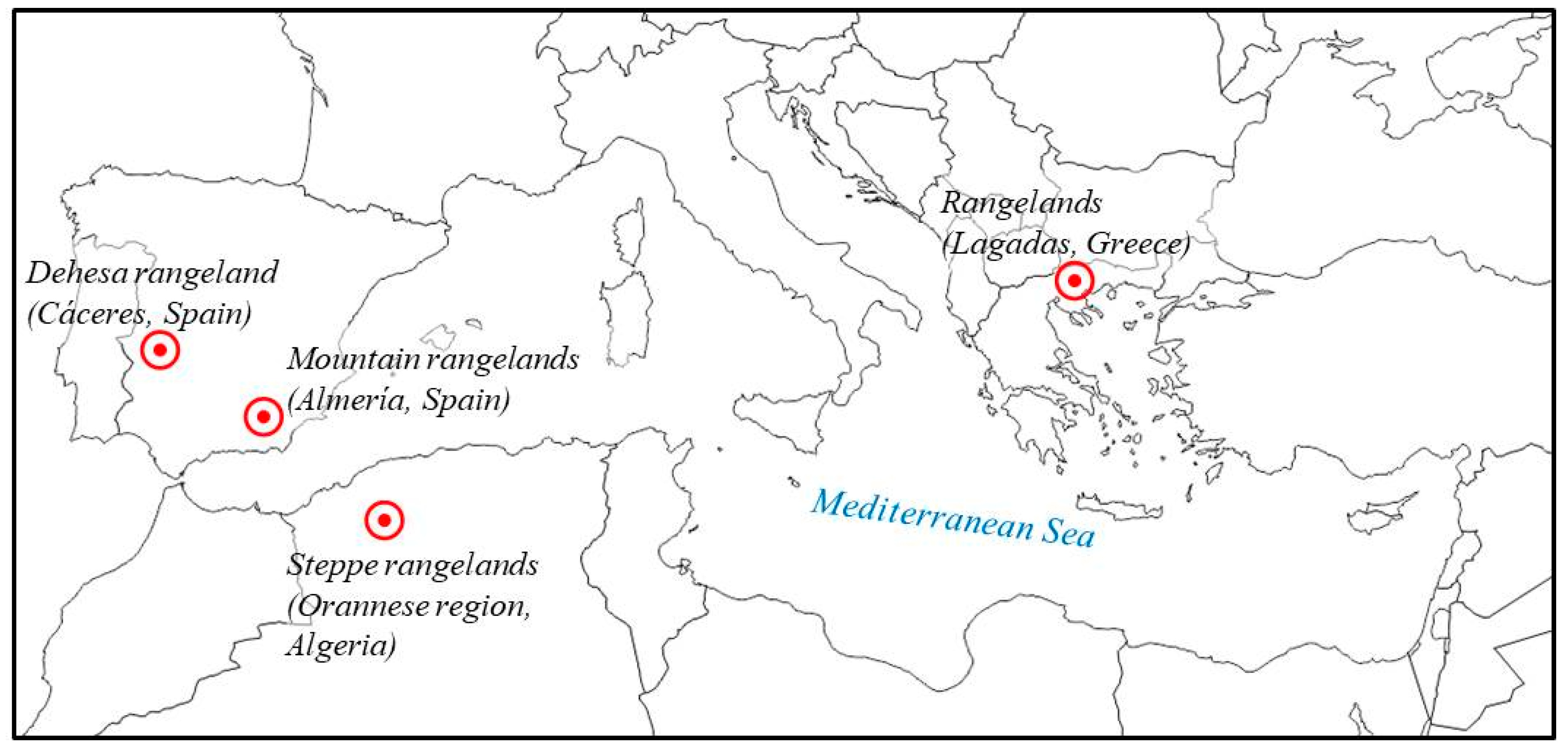
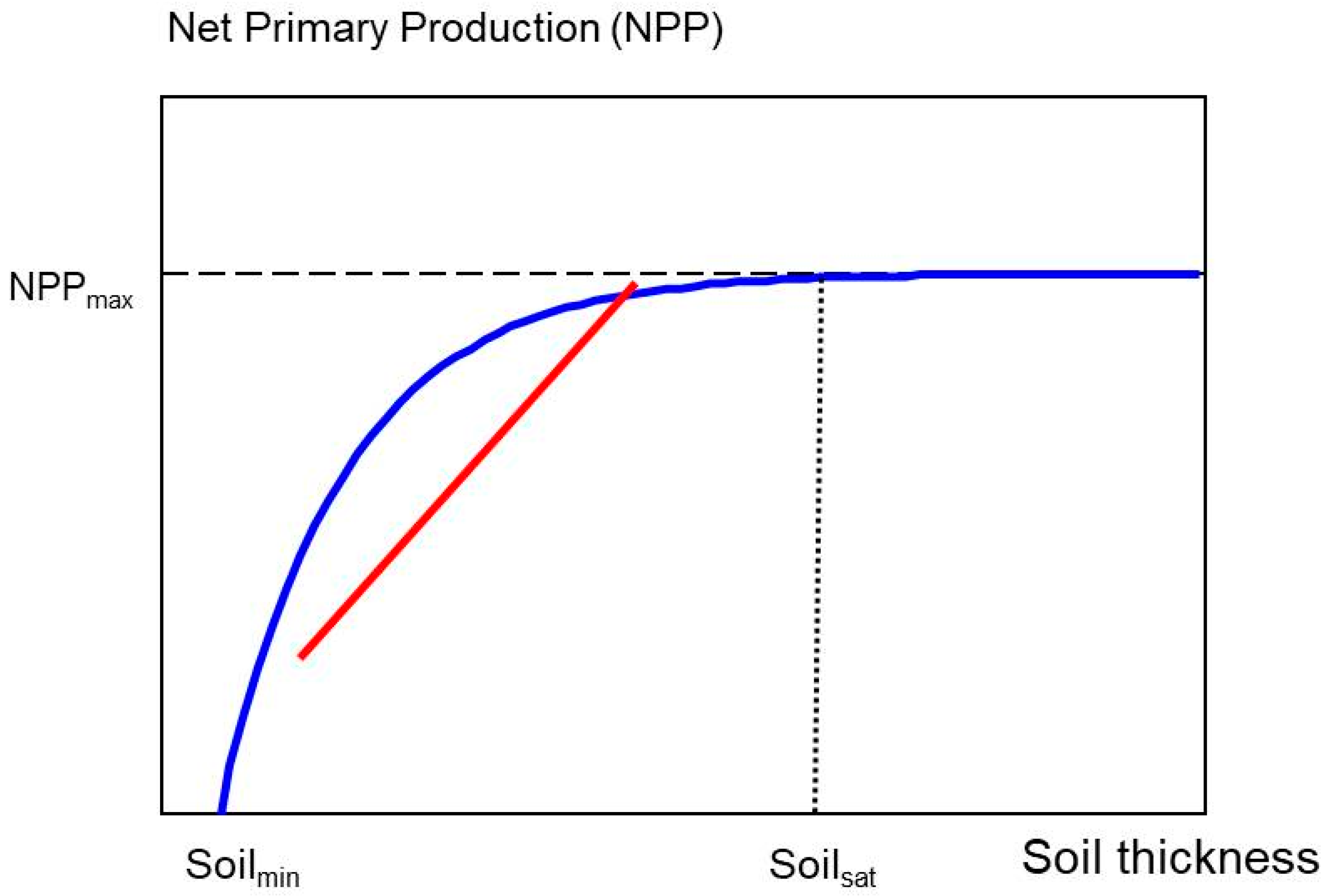
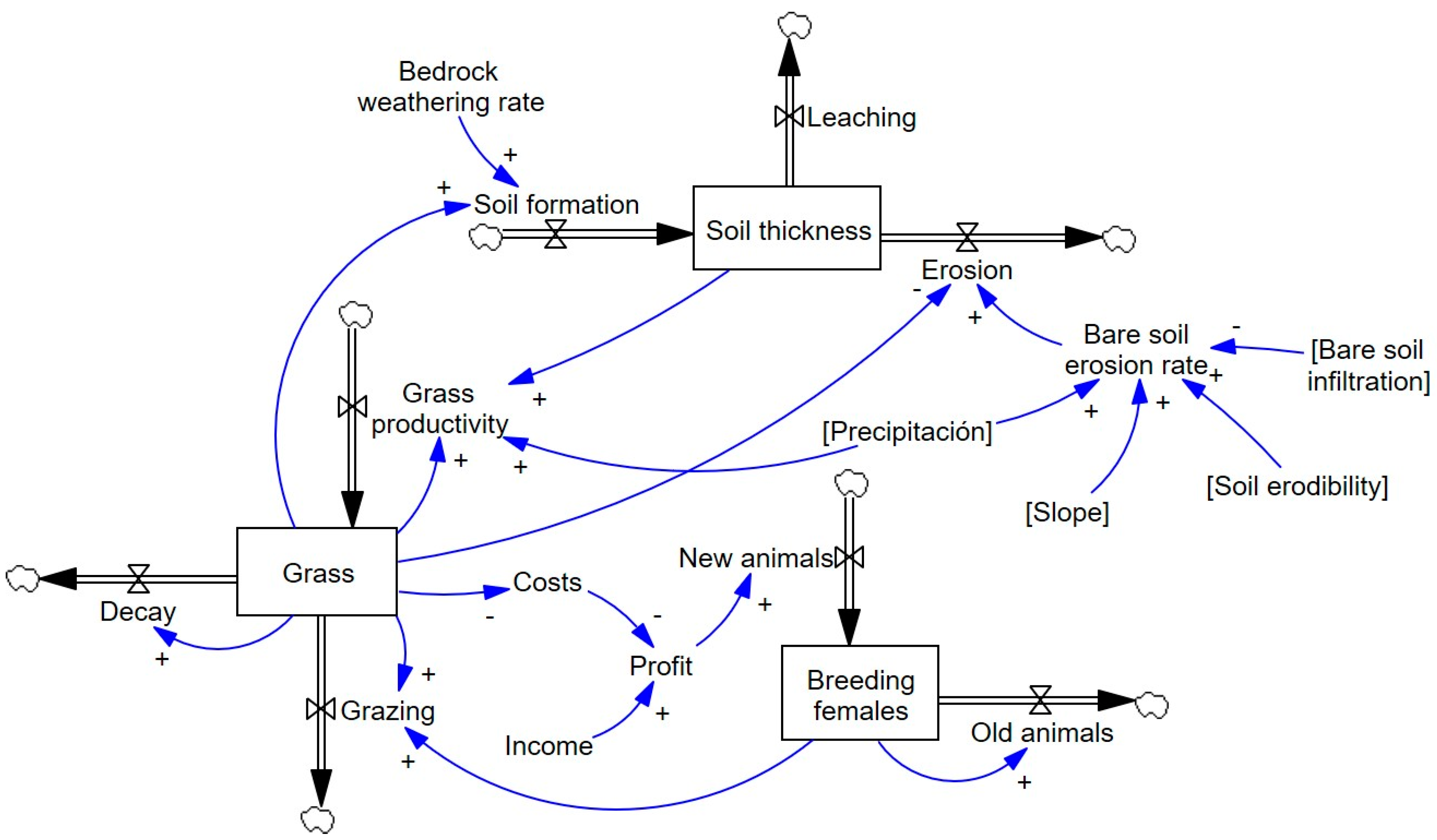
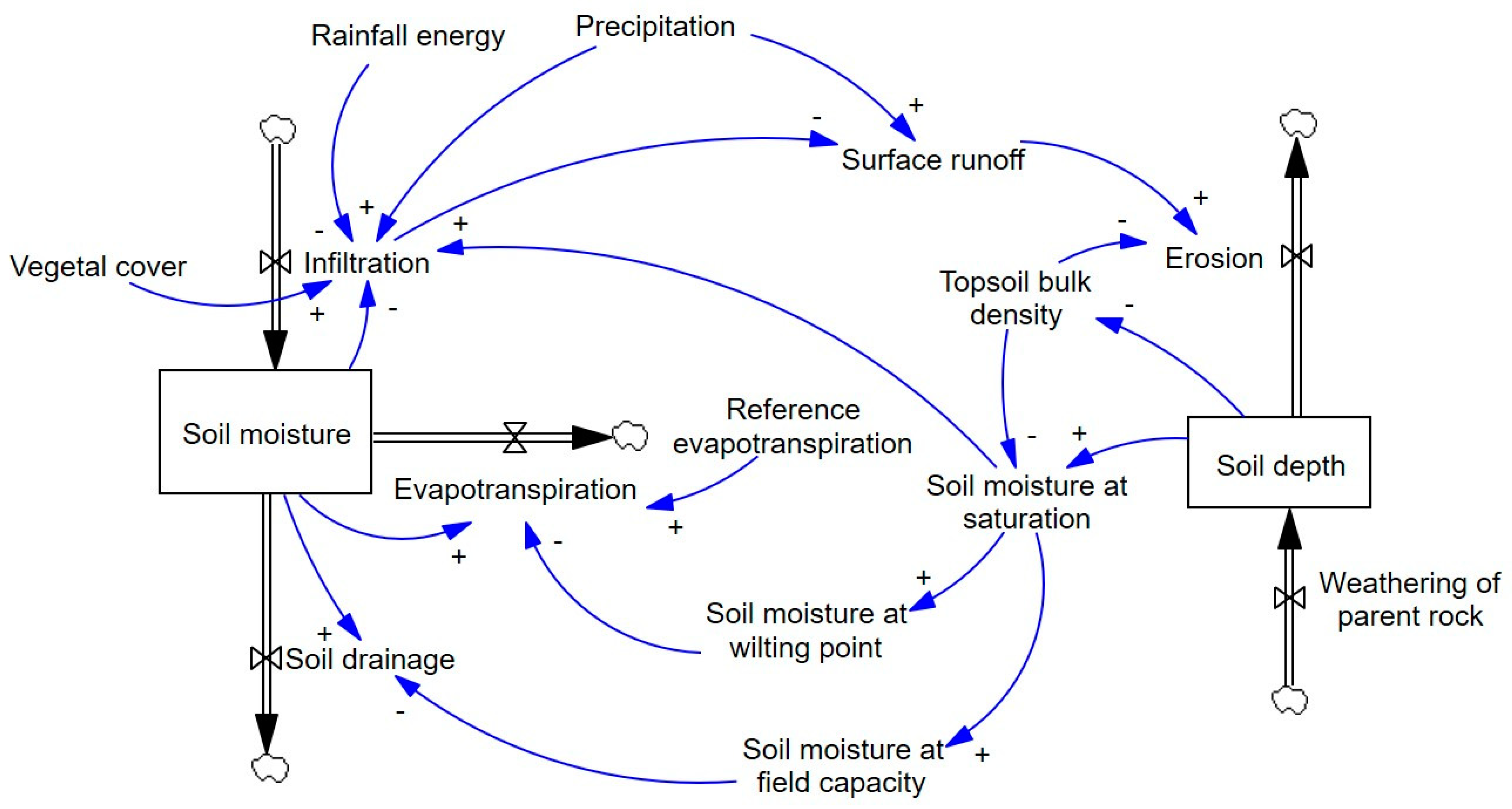
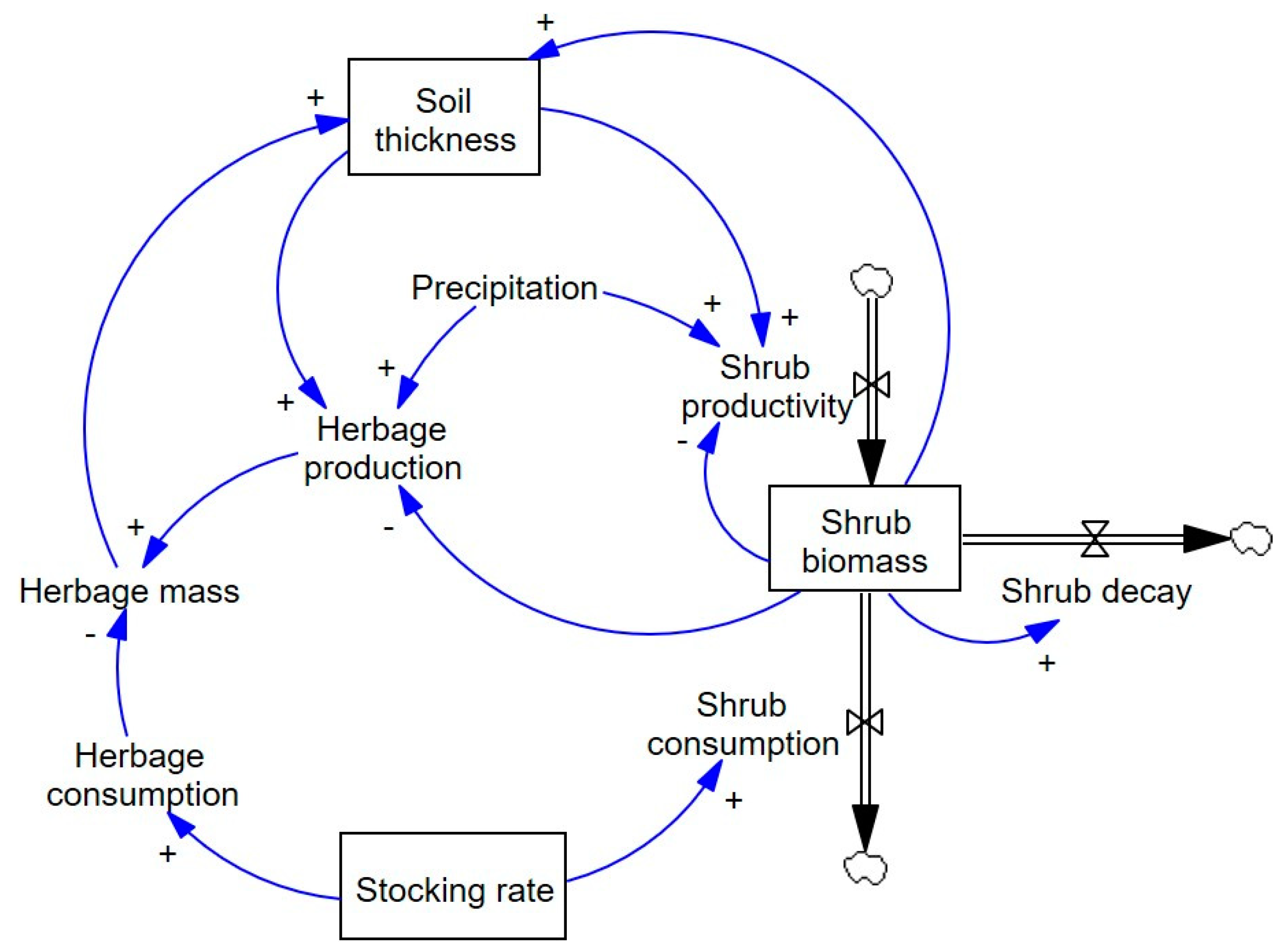
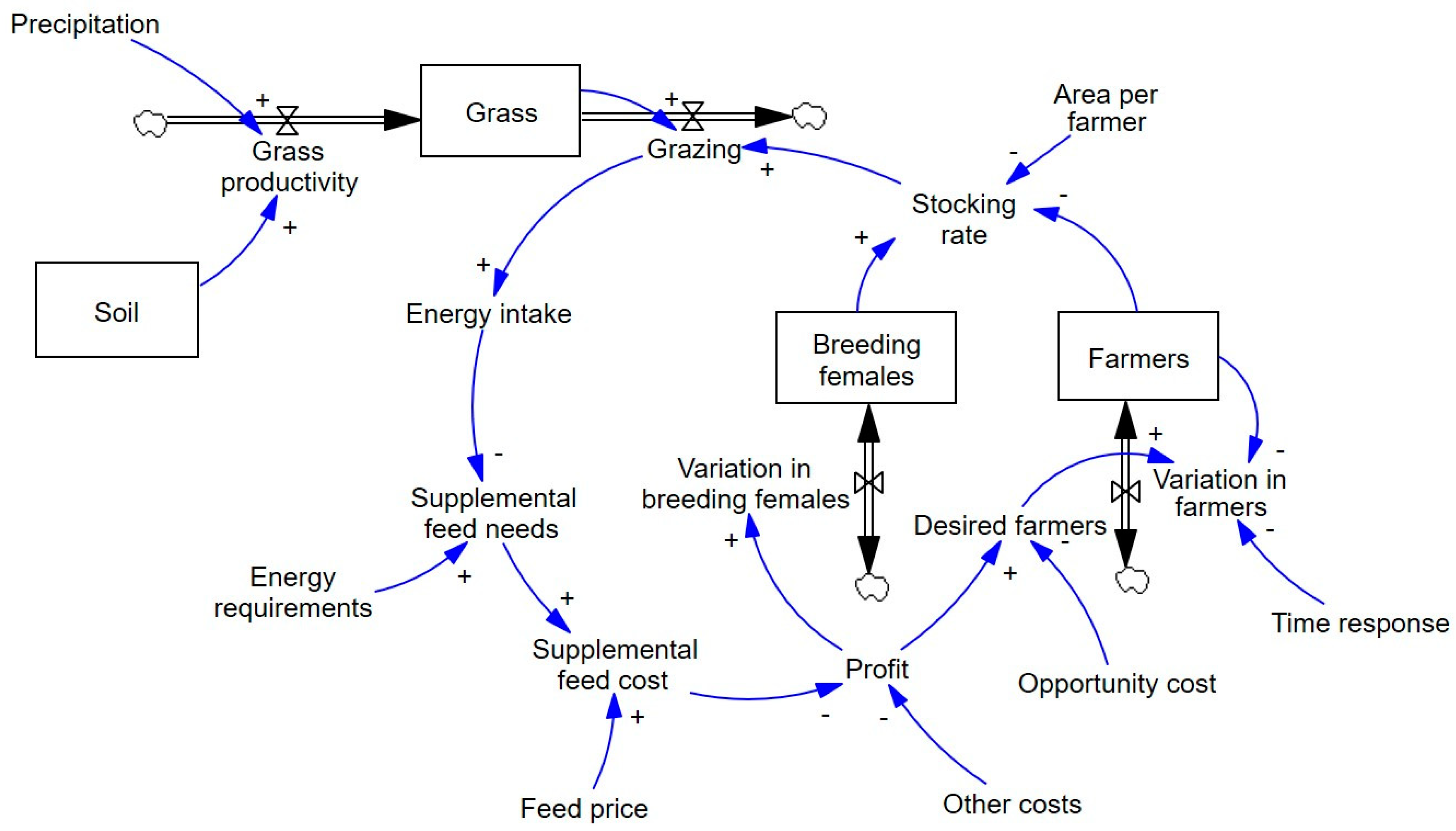
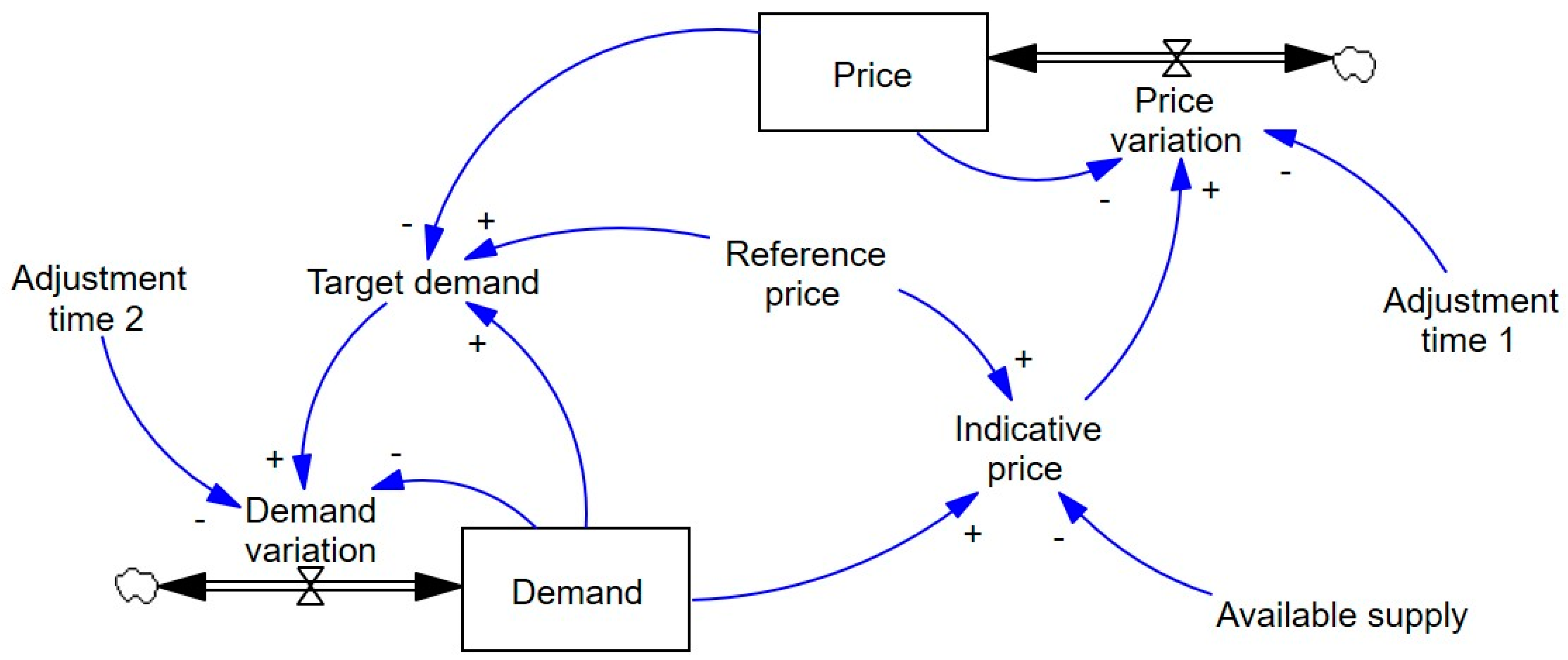





| Parameter | Impact |
|---|---|
| Mean annual precipitation | −36.9% |
| Fraction of annual precipitation that fell in the humid season | −17.5% |
| Mean annual reference evapotranspiration | 12.5% |
| Fraction of annual evapotranspiration in the wet season | 12.2% |
| Initial mean runoff coefficient soil at wilting point | −9.5% |
| Coefficient of variation annual precipitation | −8.1% |
| Coefficient of variation runoff coefficient soil at wilting point | −4.5% |
| Months when precipitation > ETo (length of the humid season) | 2.4% |
| Total subsidies per hectare | −1.4% |
| Costs per female other than the cost of supplemental feed | 1.3% |
| Mean meat price | −1.2% |
| Weathering rate of the parent rock | 1.1% |
| Average number of years to form gross margin expectations | −0.5% |
| Mean price of supplemental feed | 0.4% |
| Coefficient of variation supplemental feed | −0.2% |
| Coefficient of variation meat price | −0.2% |
| % Increase in breading females if gross margin increased by 10% | 0.1% |
| Secondary income per breeding female | 0.0% |
Disclaimer/Publisher’s Note: The statements, opinions and data contained in all publications are solely those of the individual author(s) and contributor(s) and not of MDPI and/or the editor(s). MDPI and/or the editor(s) disclaim responsibility for any injury to people or property resulting from any ideas, methods, instructions or products referred to in the content. |
© 2023 by the authors. Licensee MDPI, Basel, Switzerland. This article is an open access article distributed under the terms and conditions of the Creative Commons Attribution (CC BY) license (https://creativecommons.org/licenses/by/4.0/).
Share and Cite
Martínez-Valderrama, J.; Ibáñez Puerta, J. System Dynamics Tools to Study Mediterranean Rangeland’s Sustainability. Land 2023, 12, 206. https://doi.org/10.3390/land12010206
Martínez-Valderrama J, Ibáñez Puerta J. System Dynamics Tools to Study Mediterranean Rangeland’s Sustainability. Land. 2023; 12(1):206. https://doi.org/10.3390/land12010206
Chicago/Turabian StyleMartínez-Valderrama, Jaime, and Javier Ibáñez Puerta. 2023. "System Dynamics Tools to Study Mediterranean Rangeland’s Sustainability" Land 12, no. 1: 206. https://doi.org/10.3390/land12010206
APA StyleMartínez-Valderrama, J., & Ibáñez Puerta, J. (2023). System Dynamics Tools to Study Mediterranean Rangeland’s Sustainability. Land, 12(1), 206. https://doi.org/10.3390/land12010206



_Kazoglou.png)




